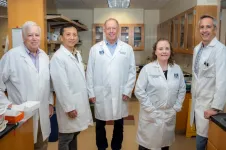(Press-News.org) COLUMBUS, Ohio – A new review of research suggests that the nature-based technology biochar – a carbon-rich material – could be an important tool to use in agriculture to help mitigate climate change.
Made by pyrolysis, a process that involves heating organic material in a low-oxygen environment, biochar – a charcoal-like, porous substance – has long been utilized for crop production as a soil amendment or carbon sequestration agent. In recent years, researchers have seen a resurgence of heightened interest in the technology due to its unique physical structure and its various agricultural and environmental benefits.
It’s for these reasons that biochar’s potential to remove large amounts of greenhouse gases from the atmosphere deserves to be re-evaluated, said Raj Shrestha, lead author of the study and a research associate in horticulture and crop science at The Ohio State University.
“When farmers grow their crops, they apply fertilizer and/or manure and use different kinds of machinery to till the soil,” said Shrestha. “In the process, greenhouse gases are produced and released into the atmosphere.”
But farmers could lessen this impact by applying biochar to their fields, according to the paper, recently published in the Journal of Environmental Quality.
“If we can convince farmers that converting biomass to biochar is good for the long-term sustainability of soils, the economy, and good for the environment, then we’ll be able to see wide adoption of this technology,” said Shrestha.
The researchers reviewed more than 200 field studies conducted across the globe that examined the impact of biochar application in agriculture on emissions of nitrous oxide, methane and carbon dioxide – heat-trapping gases that cause Earth’s atmosphere to warm.
The team found that the amount of biochar in the soil does have variable effects on local greenhouse gas emissions, which range from a decrease to an increase, and, in some cases, no change. But in general, the team discovered that the use of biochar in field settings lowered the amount of nitrous oxide in the air by about 18% and methane by 3%.
Biochar alone was also not effective at reducing carbon dioxide emissions, but did help when combined with commercial nitrogen fertilizer or other organic materials, like manure or compost.
“We can achieve negative emission in our agroecosystems by reducing the carbon source and enhancing carbon sink,” said Shrestha. Reducing Earth’s carbon source can be achieved by reducing greenhouse gas emissions from our activities, and enhancing carbon sink – increasing the technology’s ability to absorb more carbon than it releases into the atmosphere – can be done by increasing the long-term soil carbon pool through conversion of organic waste into biochar, he said.
“What’s good about biochar is that it contributes to both these aspects to create net negative agriculture,” said Shrestha.
Right now, when farmers leave crop residue on the field, only about 10% to 20% of the residue carbon is recycled into soil during the decomposition process, but by converting the same amount of residue to biochar and then applying it to the field, we can store about 50% of that carbon into stable carbon forms.”
As biochar-carbon placed in the soil can also last anywhere from a few hundred to thousands of years, it’s currently one of the proposed best management practices for achieving negative emissions and preventing Earth’s average temperature from increasing to 1.5 degrees Celsius above pre-industrial levels.
According to the study, between 2011 and 2020, global greenhouse gas emissions rose: carbon dioxide by about 5.6%, methane by 4.2%, and nitrous oxide by 2.7% – and agriculture accounts for about 16% of these emissions. While such levels have already led to irreversible changes to the global climate system, Shrestha said that future damages could be slowed by helping to curb the extent of emissions from the farming and forestry sectors.
Yet despite biochar’s potential as a negative emission technology and the recent increase in biochar-related research, it’s difficult to get farmers to apply it, partly because it hasn’t been commercialized for widespread use or promoted well, said Shrestha.
To better deliver more science-based, practical information about the technology and its benefits to farmers and agriculture-related businesses, many lawmakers have enacted policies meant to investigate its effectiveness across many different soil types and environmental conditions. It’s an objective that Shrestha shares, as the main goal of his team’s review paper is to improve farmers’ confidence in biochar so that more of them choose to adopt it sooner.
This study was supported by The Arthur P. Sloan Foundation. Other Ohio State co-authors were Laura E. Lindsey, Rattan Lal, Klaus Lorenz and Scott M. Demyan, as well as Pierre-Andre Jacinthe from Indiana University Purdue University Indianapolis, Maninder P. Singh from Michigan State University and Wei Ren from the University of Kentucky.
#
Contact: Raj K. Shrestha, Shrestha.10@osu.edu
Written by: Tatyana Woodall, Woodall.52@osu.ed
END
Researchers want to use ‘biochar’ to combat climate change
Study finds ‘green’ tech can help lower greenhouse gas emissions
2023-05-23
ELSE PRESS RELEASES FROM THIS DATE:
Researchers build bee robot that can twist
2023-05-23
PULLMAN, Wash. – A robotic bee that can fly fully in all directions has been developed by Washington State University researchers.
With four wings made out of carbon fiber and mylar as well as four light-weight actuators to control each wing, the Bee++ prototype is the first to fly stably in all directions. That includes the tricky twisting motion known as yaw, with the Bee++ fully achieving the six degrees of free movement that a typical flying insect displays.
Led by Néstor O. Pérez-Arancibia, Flaherty associate professor in WSU’s School of Mechanical and Materials Engineering, the researchers ...
How the COVID-19 pandemic impacted social cohesion
2023-05-23
Did the pandemic bring societies together or increase the drifting apart? That was one of the central questions posed by the scientists. "The empirical knowledge gained in this special issue deepens our understanding of the social consequences of the pandemic," says Dr. Mandi Larsen, a sociologist at Constructor University, "a well-founded scientific basis is also important in order to be able to better counteract future pandemics in socio-political terms." Together with her expert colleagues Dr. Georgi ...
Are we truly “inattentionally blind”? New study revisits “invisible gorilla” experiment for new insights
2023-05-23
We are quite good at spotting unexpected objects while focused on another activity if they are moving fast, reveals a new study by a team of New York University researchers. Their findings cast doubt on a long-standing view that our ability to see the unexpected is necessarily impaired when our attention is already directed elsewhere.
“For decades, it’s been thought that when we’re intently focused on something relevant, like driving or playing a game, we fail to spot something that unexpectedly enters our field of vision, even if it is clearly visible and moving,” says Pascal Wallisch, a clinical associate professor at New York University’s ...
Putting the brakes on accelerated aging of bone, muscle from HIV infection, treatment
2023-05-23
AUGUSTA, Ga. (May 23, 2023) – Antiretroviral cocktails can make human immunodeficiency virus, or HIV, undetectable and untransmittable, but both the virus and its treatment can also accelerate aging of bone and muscle.
Now Medical College of Georgia scientists are looking at drugs already being studied in clinical trials for cancer to help put the brakes on these classic indicators of aging that can lead to falls, fractures and early frailty.
“These drugs are doing what they are supposed to be doing: ...
Viewers actually 'binge-watch' TV with a lot of self-control
2023-05-23
If viewers sometimes feel guilty about binge-watching television programing, they really shouldn’t. Though its name implies impulsive behavior, binge-watching TV is a common activity planned out by viewers, suggests new research from the University of California San Diego’s Rady School of Management and School of Global Policy and Strategy.
The study, in collaboration with the Tepper School of Business at Carnegie Mellon University and Fox School of Business at Temple University, reveals that viewers prefer to binge-watch ...
Prescribed burns encourage foul-smelling invaders
2023-05-23
Though prescribed burns reduce wildfire threats and even improve habitat for some animals, new research shows these fires also spread stinknet, an aptly named weed currently invading superblooms across the Southwestern U.S.
Stinknet, also called globe chamomile, is native to South Africa, but is commonly seen in photos of California’s colorful superblooms. “Not all flowering plants are indicative of a healthy ecosystem,” said Loralee Larios, UC Riverside assistant botany professor and study co-author. “This one isn’t.”
In addition ...
Investigation reveals “shocking” epidemic of sexual assault in the NHS
2023-05-23
A joint investigation published today by The BMJ and The Guardian finds that NHS trusts recorded more than 35,000 cases of rape, sexual assault, harassment, stalking, and abusive remarks, between 2017 and 2022. The findings, which show that NHS trusts are failing to protect staff and patients, have led to calls for an independent inquiry.
The data, based on responses to Freedom of Information (FOI) requests from 212 NHS trusts and 37 police forces in England, show that a total of 35,606 sexual safety incidents were recorded ...
3 undergraduate researchers from Argonne selected for National Science Foundation Graduate Research Fellowship Program
2023-05-23
Argonne supports students’ ongoing engagement with the lab and scientific research by helping them secure a graduate fellowship.
Three students who have completed their participation in the Science Undergraduate Laboratory Internships (SULI) Science Undergraduate Laboratory Internships Program at the U.S. Department of Energy’s (DOE) Argonne National Laboratory were accepted into the National Science Foundation’s (NSF) Graduate Research Fellowship Program (GRFP). Their achievements highlight the important role Argonne plays in students’ continued engagement in science, technology, engineering and mathematics (science, technology, ...
UC San Diego first to test cancer drugs in space using private astronaut mission
2023-05-23
On May 21, 2023, scientists at University of California San Diego Sanford Stem Cell Institute launched several new nanobioreactor experiments onto the International Space Station (ISS) via the second Axiom Space Private Astronaut Mission, Axiom Mission 2 (Ax-2). The latest experiments expand their research on human stem cell aging, inflammation and cancer in low Earth orbit.
Increasing evidence shows that microgravity conditions can accelerate aging, inflammation and immune dysfunction in human stem cells. Understanding this process is not only helpful for keeping astronauts healthy — it could also teach us how to better treat ...
Research favors testing and voluntary isolation over closures in disease outbreaks
2023-05-23
Regular diagnostic testing and self-isolation can be more effective than school and business closures when it comes to combating infectious disease outbreaks such as COVID-19, according to a new study by University of Wyoming researchers.
The findings appear today (Monday) in Scientific Reports, an online, open access journal from the publishers of Nature.
UW Department of Economics faculty members Stephen Newbold, David Finnoff, Jason Shogren and Linda Thunstrom, along with recent Ph.D. graduate Madison Ashworth, developed an epidemiological and economic model to compare the effectiveness of physical distancing mandates with policies encouraging regular testing and ...
LAST 30 PRESS RELEASES:
New expert guidance urges caution before surgery for patients with treatment-resistant constipation
Solar hydrogen can now be produced efficiently without the scarce metal platinum
Sleeping in on weekends may help boost teens’ mental health
Study: Teens use cellphones for an hour a day at school
After more than two years of war, Palestinian children are hungry, denied education and “like the living dead”
The untold story of life with Prader-Willi syndrome - according to the siblings who live it
How the parasite that ‘gave up sex’ found more hosts – and why its victory won’t last
When is it time to jump? The boiling frog problem of AI use in physics education
Twitter data reveals partisan divide in understanding why pollen season's getting worse
AI is quick but risky for updating old software
Revolutionizing biosecurity: new multi-omics framework to transform invasive species management
From ancient herb to modern medicine: new review unveils the multi-targeted healing potential of Borago officinalis
Building a global scientific community: Biological Diversity Journal announces dual recruitment of Editorial Board and Youth Editorial Board members
Microbes that break down antibiotics help protect ecosystems under drug pollution
Smart biochar that remembers pollutants offers a new way to clean water and recycle biomass
Rice genes matter more than domestication in shaping plant microbiomes
Ticking time bomb: Some farmers report as many as 70 tick encounters over a 6-month period
Turning garden and crop waste into plastics
Scientists discover ‘platypus galaxies’ in the early universe
Seeing thyroid cancer in a new light: when AI meets label-free imaging in the operating room
Neutrophil-to-lymphocyte ratio may aid risk stratification in depressive disorder
2026 Seismological Society of America Annual Meeting
AI-powered ECG analysis offers promising path for early detection of chronic obstructive pulmonary disease, says Mount Sinai researchers
GIMM uncovers flaws in lab-grown heart cells and paves the way for improved treatments
Cracking the evolutionary code of sleep
Medications could help the aging brain cope with surgery, memory impairment
Back pain linked to worse sleep years later in men over 65, according to study
CDC urges ‘shared decision-making’ on some childhood vaccines; many unclear about what that means
New research finds that an ‘equal treatment’ approach to economic opportunity advertising can backfire
Researchers create shape-shifting, self-navigating microparticles
[Press-News.org] Researchers want to use ‘biochar’ to combat climate changeStudy finds ‘green’ tech can help lower greenhouse gas emissions





